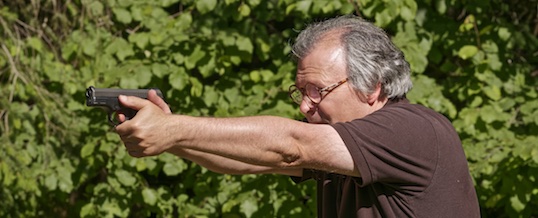
Defensive shooting fundamentals: I do not think it means what they think it means.
I want you to sit back and think for just a minute: you have 60 seconds to teach someone how to use a gun to defend herself from an imminent attack. What useful defensive shooting fundamentals can you give her in that small amount of time?
This little exercise strips away all of the nonsense, hype, and posturing that often surrounds defensive shooting training. I makes you really focus on the most important parts of teaching someone how to defend themselves with a firearm. Why, then, when I ask other instructors to play this “what-if” game do they usually end up telling me something very different than what they actually teach their students?
What are defensive shooting fundamentals?
Over the years I’ve had many interesting conversations with other instructors. I’ve heard definitions of defensive shooting fundamentals that vary rather dramatically from mine. For instance, one fellow insisted that breath control was an absolutely critical part of defensive shooting. Another told me that his classes started with a day of dry-fire, because that was the only way new students could possibly learn fundamentals. Some have said that tactical reloads are a fundamental skill. And so it goes.
When faced with our little thought project, however, those things just sort of fall by the wayside. In that 60 seconds breath control becomes irrelevant, and as for dry-fire…well, doesn’t that seem awfully silly?
In those 60 seconds you’re going to distill the task down to simple steps: how to grasp the gun; stand in a natural way and bow forward slightly; extend both arms to bring the gun into and parallel with your line of sight while focusing on the spot you need to hit; press the trigger straight back, as many times as necessary, until the attack stops.
Yes, you can do all that in 60 seconds. You won’t, however, have time for breathing exercises or dry fire. (The Weaver/Isosceles debate?? Ain’t no one got time for that!)
“Do as I say, not as I do”
Regardless of the dogma an instructor spouts, that’s pretty close to how most of them answer the question. If that’s the case, why do so many teach their students something different? If they agree, even tacitly, that those are the distilled defensive shooting fundamentals, why aren’t they starting their students with them?
I don’t know, but I suspect tradition and peer pressure play a big part. We all want to do things the “right” way, defined as the way that a certain percentage of others do them. If everyone else is over-complicating things, we’ll feel a need to do so as well. That’s how you get to a full day of dry fire for beginning students when they really need to be focusing on hitting a target.
Efficient grasp, natural stance, target focus, extended arms, multiple shots until the threat stops. Those are the REAL fundamentals. They’re what we’d teach someone who needed to use a gun right now. That’s what’s important, what’s most useful, and everything else in defensive shooting should build on those fundamentals.
Fundamentals should always be relevant
This is a very different point of view from the rest of the defensive training world, but I think it’s the logical one. We should start with those critical fundamentals then build on them to expand the range of a student’s skills. Interestingly, when you look at self defense in the private sector the shooting skills needed really aren’t all that great; it’s the decision making skills and the ability to recognize an attack in time to mount a defense that are really critical. Still, there are defensive shooting skills which go beyond these fundamentals and by all means should be taught. If they conflict with what we’d teach in a pinch, though, maybe they really aren’t all that important.
“The Fundamentals” of defensive shooting aren’t about precision trigger or breath control; they’re about how to get rapid, multiple, accurate hits on a threat at plausible distances under plausible circumstances. Anything that leads us away from that, no matter how athletic or impressive it may be, probably doesn’t serve the student all that well.
(None of this should be construed to mean that there is no place for precision shooting skills in self defense. There are situations where they could in fact be needed. What I am saying is that the situations under which those skills are necessary are a very small percentage of incidents. Fundamentals should be about focusing on the most needed skills for the most common situations first, and only after that expanding the skills as need dictates.)
Are you really learning — or teaching — what’s important?
If you’re a student, seek out those who understand what defensive shooting fundamentals are really about. You should, from the very first hour, be learning things that will help you immediately if you’re suddenly attacked. Isn’t that why you have (or carry) that gun in the first place?
If you’re an instructor who purports to teach defensive shooting, you should be thinking about what your students are really going to need when they walk off your range for lunch on the first day. Yes, they should actually have learned real self defense skills by lunchtime on Day One. That doesn’t mean a great range of skills, but what they do learn should at least allow them to defend themselves from a common attack. Right now. It’s all about integrity.
None of that can happen from doing breathing exercises.
– Grant Cunningham
Now you can LISTEN to the blog!
- Posted by Grant Cunningham
- On August 1, 2016



